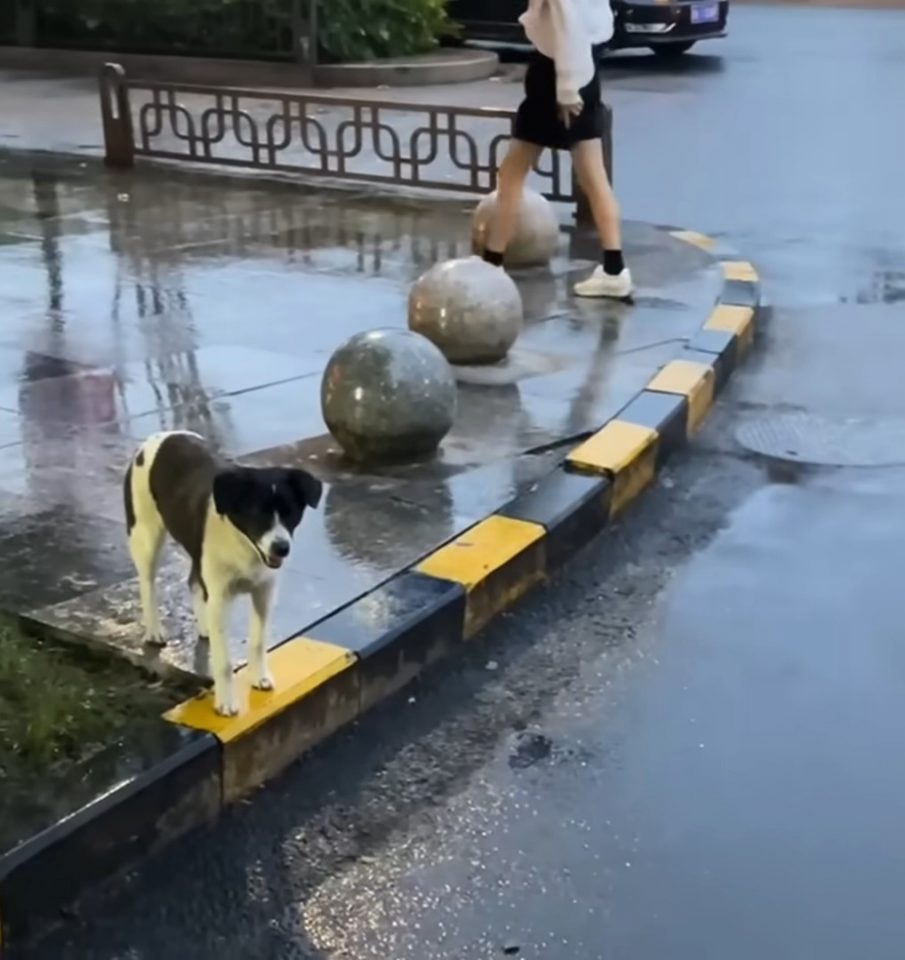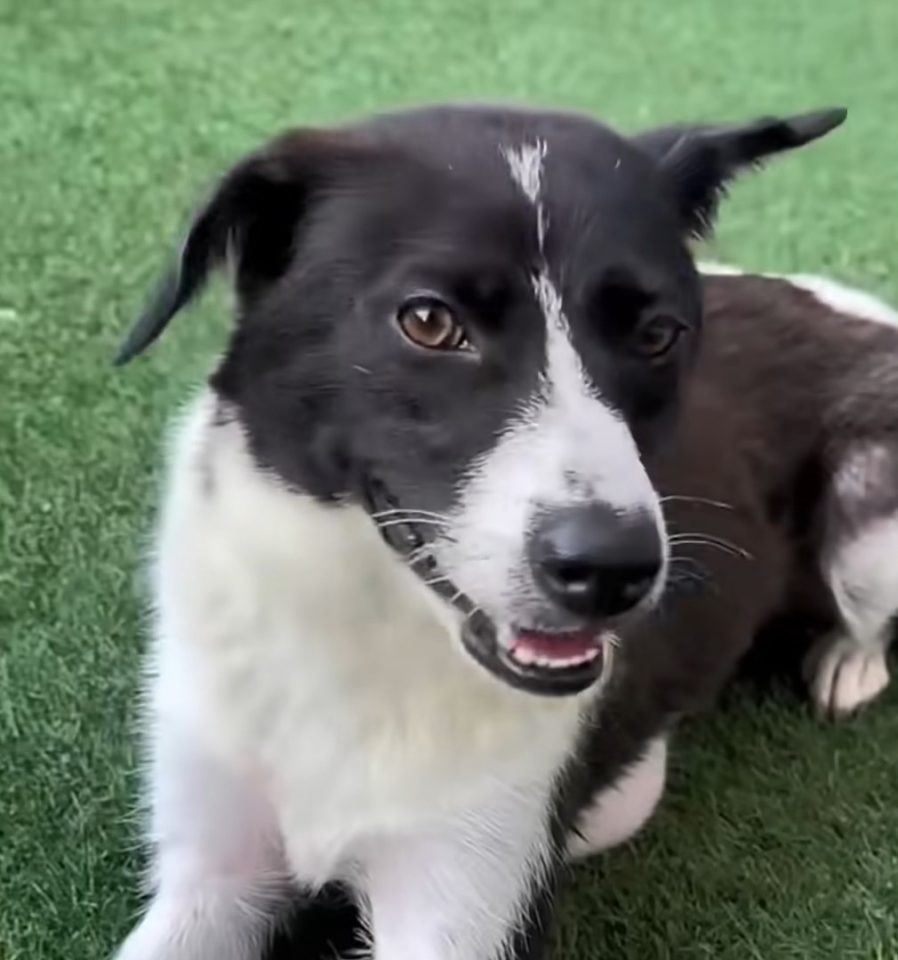It’s not often that I encounter a stray dog who needs help. However, when I do, I try to be there for them and at least give them something to eat.
While it’s not much, this simple act can help him push on and potentially find someone willing to take him in.
Most of the time, they won’t even approach you, or they will just ignore people completely. However, seeing one who is clearly asking for help just always breaks my heart.
In situations like this, when they desperately need us, we should do more to help them. In this story, we will talk about a pregnant dog who begged strangers for food in front of a restaurant.
She Was Starving

When a group of people gathered for a party in their local restaurant, they were surprised by the presence of a dog nearby.
They didn’t know where she came from, but it was apparent that she was a stray who needed some help.
Who knows how long she had been on her own. However, her struggle didn’t go unnoticed. A few kind people realized that she needed some help, so they decided to do something about it.
Upon seeing the dog, a guard chased her away, but the people who wanted to help got close and comforted her for a bit.

She was very friendly and they wanted to figure out some sort of plan to help her, so they asked the guard if she could stay at the entrance of the restaurant until they left.
He agreed, and she stayed there the whole time. Later, they realized that she was pregnant, and they rushed her to a clinic for a checkup.
She had a small fever, but nothing that medications couldn’t fix. During the whole process, she was really calm and trusted her rescuers to do what was best.
The X-rays revealed that she indeed was pregnant, but they also revealed something potentially concerning. It was a small tumor on her stomach.
They ran some more tests to see what kind it was, and they concluded that it was a benign tumor and she was safe. All she needed was some medications to treat it.
The Puppy Was So Sweet

While in their care, everything went smoothly, but something changed during the evening. At around 2 AM, they heard some noise and decided to check it out.
She started giving birth, and they immediately rushed to help her. Everything was fine, and the mama dog gave birth to a beautiful puppy.
The baby was healthy and the mom’s instincts immediately kicked in as she was doing everything to care for her.
After two weeks, the rescuers noticed that the puppy opened her eyes and started exploring her environment.
The baby is still never too far away from her mom and is just enjoying her time in the wonderful home she is staying in.

The rescuers also decided to give the mother a warm bath, and she really enjoyed it. They then opened up the terrace area where the mom and her baby could go out and just play for a bit.
Two months went by and it was already time for the puppy’s vaccinations and a checkup. They were glad to learn that both of them were very healthy.
They were now living a completely different life. All of their needs were met and they had wonderful people who took care of them.
It’s beautiful to see how kindness and persistence can help save a dog’s life and also improve our own.
If you’ve ever wondered about the journey of your furry companion from a tiny pup to a full-grown dog, you’re not alone. Understanding when your dog reaches their maximum size can help you plan for their care and development. As a seasoned dog trainer, you know that each stage of a dog’s growth comes with its unique joys and challenges.
Watching your canine friend grow and mature is a remarkable experience filled with surprises and milestones. From those playful puppy days to the moment they reach their adult size, the growth process is a fascinating part of your dog’s life. Stay tuned to discover more about the intriguing world of canine development.
Factors Affecting Dog Growth
When it comes to understanding when your furry friend will stop growing, several factors play a crucial role in determining their overall size and development. Let’s take a look at some key factors that can influence your dog’s growth:
1. Breed
Different dog breeds have varying growth rates and final sizes. Larger breeds like Great Danes reach their full size much later than smaller breeds like Chihuahuas. Understanding your dog’s breed characteristics can give you insight into their growth trajectory.
2. Genetics
Genetics play a significant role in determining how big your dog will grow. If your dog comes from a line of large parents, they are likely to be on the bigger side as well. On the other hand, smaller parents generally produce smaller offspring.
3. Nutrition
Proper nutrition is essential for healthy growth in dogs. A well-balanced diet with the right mix of nutrients ensures that your pup develops properly. Consult your veterinarian to ensure you’re feeding your dog appropriately for their age, size, and breed.
4. Health
Any underlying health issues can impact your dog’s growth rate. Regular check-ups with your vet can help identify and address any health concerns that could be affecting your dog’s development.
5. Exercise
Regular exercise is vital for your dog’s overall health and development. It helps build strong muscles and keeps your furry companion fit. However, excessive exercise in growing puppies can be detrimental, so it’s important to strike a balance.
Understanding these key factors can give you valuable insights into your dog’s growth journey. By providing the right environment, care, and attention, you can ensure that your four-legged friend reaches their full potential in a healthy and happy manner.
Signs of Growth Plate Closure
Wondering when your furry friend stops growing? Here are the signs to look out for to determine if your dog’s growth plates have closed.
- Age Milestones: Typically, small breeds’ growth plates close around 9-12 months, medium breeds at 12-18 months, and large breeds around 18-24 months. This closure indicates the end of major growth spurts.
- Physical Changes: Watch for signs like a stable height and weight for at least a few months, as well as a more defined and adult body shape.
- Behavioral Cues: Dogs may exhibit less puppy-like behavior, showing increased focus, calmness, and less inclination to play as they mature.
- Inactivity during Growth: Rest is crucial during growth spurts, so a decrease in activity, especially in larger breeds, can signal growth plate closure.
- Veterinary Guidance: Regular check-ups with your vet can help monitor your dog’s growth and confirm if the growth plates have closed.
- X-rays: In some cases, X-rays can determine if the growth plates have closed, providing a more accurate assessment of your dog’s growth stage.
Keeping an eye out for these signs will help you understand when your dog has reached its full size and maturity, ensuring you provide the best care at every stage of their growth journey.
Average Age for Growth Plate Closure
Once your dog gets to a certain age, their growth plates close, indicating they have reached their full size. Here’s a general timeline for the closure of growth plates based on the size of the dog:
- Small Breeds
Around 8 months of age, most small breeds have their growth plates closed. These include breeds like Chihuahuas, Toy Poodles, and Dachshunds. - Medium Breeds
For medium breeds such as Bulldogs, Cocker Spaniels, and Beagles, growth plates typically close between 12 to 16 months of age. - Large Breeds
Large breeds like German Shepherds, Golden Retrievers, and Great Danes usually have their growth plates closed by 12 to 18 months of age.
Monitoring your dog’s growth and understanding when their growth plates close is crucial for their overall health and well-being. It’s essential to consult your veterinarian to ensure your dog is developing correctly and to receive guidance on appropriate care during this critical stage of their life.
Monitoring Growth in Dogs
When it comes to monitoring your dog’s growth, it is essential to track their progress regularly to ensure they are developing as expected. Here are some key points to help you keep an eye on your furry friend’s growth:
1. Regular Vet Visits
Visiting your veterinarian regularly is crucial in monitoring your dog’s growth. Your vet can provide you with valuable insights into your dog’s development and offer guidance on proper nutrition, exercise, and overall health.
2. Body Condition Score
Keeping an eye on your dog’s body condition score can help you track their growth. A healthy weight is key to your dog’s overall well-being, so it’s important to monitor their body condition and adjust their diet and exercise routine accordingly.
3. Growth Plate Closure
Understanding when your dog’s growth plates close is essential for proper growth monitoring. Small breeds typically reach growth plate closure around 8 months, while medium breeds do so between 12 to 16 months, and large breeds by 12 to 18 months. Knowing these timelines can help you assess your dog’s growth progress accurately.
4. Growth Charts
Keeping track of your dog’s measurements and weight on a growth chart can provide you with a visual representation of their growth trajectory. You can easily identify any sudden growth spurts or lags, allowing you to address any concerns promptly.
5. Consistent Monitoring
Consistency is key when monitoring your dog’s growth. Regularly measuring your dog’s height, weight, and body condition score can help you detect any issues early on and ensure they are growing at a healthy pace.
By staying proactive and observant in monitoring your dog’s growth, you can provide them with the care and support they need to thrive throughout their developmental stages. Remember, each dog is unique, so consulting your vet for personalized advice is always a good idea.
Conclusion
So, now you know the ins and outs of when dogs stop growing. Remember, each pup is unique, and factors like breed, genetics, and nutrition play a big role. Keeping an eye on your furry friend’s growth milestones is key. Regular vet check-ups, watching their body condition, and using growth charts are your best buddies. Stay proactive and seek guidance from your vet for a tail-wagging journey through your dog’s growth stages. Happy growing, pupper parent!
Frequently Asked Questions
When do dogs typically stop growing?
Dogs generally reach their maximum size and stop growing between 6 months to 2 years of age, depending on their breed size.
How can I monitor my dog’s growth?
Monitor your dog’s growth by scheduling regular vet visits, tracking body condition score, understanding growth plate closure timelines, using growth charts, and maintaining consistent monitoring for healthy development.
Why is it important to monitor a dog’s growth?
Monitoring a dog’s growth is crucial to ensure proper care, early detection of issues, and providing individualized guidance for healthy development at different life stages.
[no_toc]

Hey there, I’m Janet Brooks, a dog-loving student from California. I’m all about helping pups in need, especially those without homes. Me and my awesome friends work together to give shelter and love to stray dogs. Oh, and I also write blogs about dogs to share helpful info.